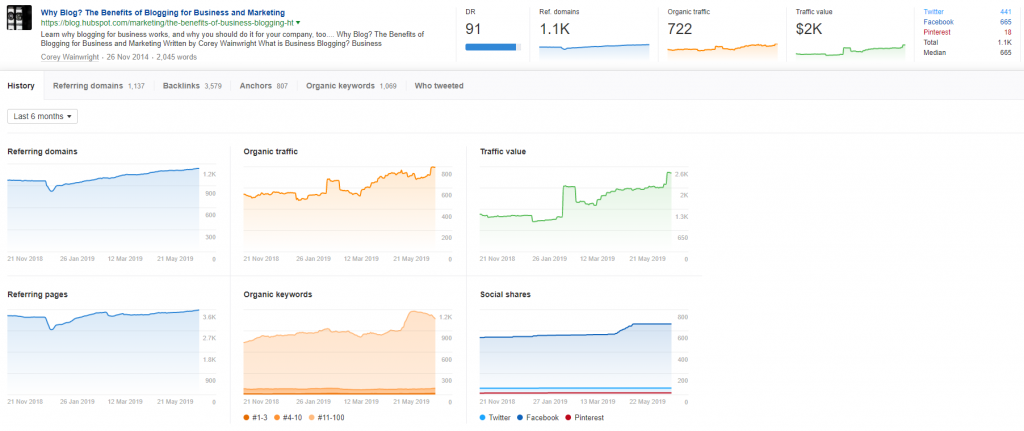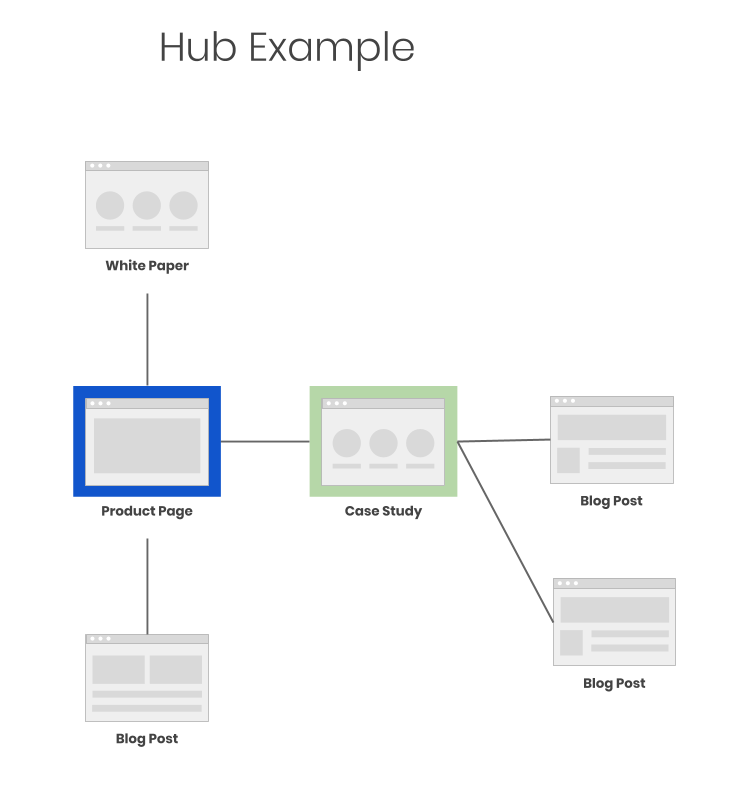Blogging has been a hot-button topic among Portent’s clients for the last decade, with no signs of abating. And given the evidence that shows a blog is beneficial for your brand, it’s not surprising why so many people are passionate about creating one for their business.
The purpose of a blog is to generate brand awareness, engage your customers on a more authentic and intimate level, create new opportunities to generate sales leads, and improve the overall optimization of your website.
Multiple studies by HubSpot reveal that businesses with quality blogs have better digital marketing results than their counterparts without blogs. Hubspot’s researchers concluded that, on average, a business with a high-quality blog earns:
- 55 percent more online visitors;
- 97 percent more inbound links;
- 434 percent more indexed pages; and
- 67 percent more leads.
Although blogging can provide significant benefits, the investment is not a universal lifeline for all businesses and industries.
For example, the fabless semiconductor manufacturer TSMC, which produces high-performance computer parts for companies like AMD and Qualcomm, doesn’t have a blog. And they shouldn’t. As a niche, complex business, TSMC’s content resources are better spent on creating white papers and case studies that show data-driven benefits of their services.
However, a B2C brand like REI has an excellent blog, and they need it. REI’s content marketing efforts are well-spent by connecting with consumers via educational articles and videos about outdoor hobbies, many of which REI happens to sell products for.
So how do you know if a blog is going to help your company?
Does Your Business Need a Blog?
The first step to answering this question … is answering other questions. It’s crucial to determine if blogging is an intelligent fit for your industry and your customers. We recommend you answer the following three questions:
- Why do you want a blog?
- What type of content would you produce?
- Do your customers want this content?
These three questions keep your eyes focused on meaningful content marketing KPIs, allowing you to evaluate if blogging is a smart investment of your time and effort. If you can’t answer the questions, or the answer to one of them is “no,” your business’s resources are likely better spent on other content marketing efforts, like a content hub strategy.
Before you can reap the benefits of blogging, which we’ll discuss in the next section, there are two additional factors about how to write a good blog post that you should consider.
Good Blog Posts Require Time
Bloggers who self-report “strong results” from their content marketing efforts are spending more time than ever on creating articles.
Each year, Orbit Media polls more than 1,000 bloggers to learn how content marketing is evolving. Based on their 2014 survey, the average blog post took about 2.5 hours to write and was roughly 800 words long. In 2018, bloggers spent 44 percent more time writing an article, with the average post taking 3.5 hours to write and surpassing 1,150 words in length.
The additional time spent writing creates positive results. According to Orbit’s survey, 25.8 percent of content creators say they saw “strong results” on posts when they spend 3-4 hours writing each article, and 56 percent of authors who spend 6 or more hours on a 2,000-plus word post say they see quality ROI for their efforts.
Ready to write your blog post? Learn about how I found the ideal SEO article length.
On the flip side, although businesses are investing more time into blogging, they’re publishing less frequently while maintaining good results. In 2014, survey respondents often published posts several times per week. In 2018, most people are publishing articles several times per month.
Quality Content is Non-Negotiable
The tough reality of blogging is that most of your posts won’t achieve meaningful results simply by publishing random content to your website.
More than 2 million blog posts are published daily, and based on an analysis by the SEO tool Ahrefs, 90.88 percent of all pages online get zero traffic from Google. Of the posts that do get organic search traffic, 4.5 percent of them get fewer than ten visits per month.
For your blog posts to join the ranks of the coveted 4.62 percent of pages that do get significant web traffic, you’ll need to create quality content.
You’ll have the best chance at success if your blogging process contains the following attributes:
- Customer-focused, data-driven topic selection
- Keyword research
- Robust writing and editing processes
- Social media amplification
- Off-page SEO or link building
Although creating good blog content isn’t an easy process, (which is why 64 percent of B2B companies outsource their blog writing,) there is good news: The benefits of creating thumb-stopping blog content are worth the effort.
The Business Benefits of Blogging
The benefits your business can get from blogging depends on what your answer is to the first question we posed: why do you want a blog? Your goals dictate what content you need to produce, which in turn will create the specific benefits you can reap.
For example, if you sell audiophile-grade headphones and want your blog to increase sales, you could create a blog post that breaks down the technical differences of high-quality Bluetooth headphones vs. AirPods, drawing users toward your content because they’re looking to replace the shoddy equipment they currently have. If your post begins ranking well on search engines, you’ll see increased website traffic and potentially increased sales, too.
Ultimately, the benefits of your blog depend on its purpose and your goals.
However, quality blog posts do offer several near-universal boons.
Increased Website Traffic
Increased website traffic, in the form of pageviews from organic and social sources, is the first quantifiable reward from your blog. Every time you publish a new post, you get another opportunity for web crawlers to discover your website and suggest it to users who search for relevant queries.
How much traffic you can earn from your blog depends on the topics you choose to discuss, how much you promote the articles, and how good the content is. Marketing researchers and publications have wildly ranging stats on how much traffic you can expect.
As we mentioned earlier, HubSpot says the average business can get 55 percent more visitors with a blog, whereas Impact claims you’ll see a 30 percent traffic increase after writing 21 to 54 blog posts. Marketing gurus like Brian Dean and Neil Patel say your blog can increase website traffic by 200,000 visitors a month or up to 206 percent, respectively.
Here’s the catch: the results you’ll uncover in any article won’t mirror the exact amount of traffic you’ll gain. Some of them might not even be close, so don’t jump too far down the traffic rabbit hole bounding after what stats one person tells you to expect.
The best way to determine how much traffic you might receive is by researching traffic estimations for content that discusses the same topic as your article. There are plenty of tools to help you gather this information. Our recommendations are Ahrefs, Buzzsumo or SEMRush.

The above screenshot is from Ahrefs’ Content Explorer, which shows data for a chosen content topic. Using the provided information, you can estimate your blog’s potential to gain organic traffic, keywords, and backlinks based on what currently ranks well. If you’re able to rank higher than the content you’re evaluating, over time you should begin earning similar KPI metrics.
However, if you’re on a budget and don’t want to splurge on an all-in-one tool, you can get a ballpark estimate of the potential web traffic increase by evaluating keyword traffic with Moz Keyword Explorer. An alternative is Keywords Everywhere, a free web browser plugin that shows you relevant search volume data while you’re exploring Google rankings.
And the best part? Top-performing blog posts typically earn compounded organic traffic, giving you increased month-over-month traffic, social shares, and leads.
Create Long-Term Relationships and Trust with Customers
Online, people flock to authority figures. If you have useful, authoritative content that connects with users and helps them, they’re more likely to see your content as the resource to answer whatever burning questions they have. The better you answer their questions, the more likely it will be that those users will return whenever a new question surfaces.
For some people, evaluating blog posts to establish trust is necessary before engaging with your company in more meaningful ways. According to research by DemandGen, 47 percent of B2B customers read 3-5 blog posts or content pieces prior to contacting a company or talking with a salesperson.
As an additional bonus, blog posts make great opportunities for your social media team to share fresh content and ideas with users. Plus, loyal users are more likely to share your content on social media, and 94 percent of people who share blog articles on social media do so to help other people, which creates a cyclical feedback loop of increased traffic and shares.
Improved Brand Awareness Through Share of Voice
Blogs also increase your website’s authority in search engines. The more quality content you produce, the higher your domain authority grows and the easier it will be to get future content ranking.
As your content rankings improve, your blog and website begin accumulating more keywords, which allow your content to show up more frequently and furthers your authority among search engines and searchers alike.
This authority is known as share of voice, a measurement you can track with the SEO tool STAT. Share of voice evaluates how visible your brand is in organic search results for a predetermined set of keywords.
A strong share of voice means your content ranks well for competitive, high-volume keywords. While your share of voice improves, your other organic-focused KPI’s often mimic that improvement.
Internal Linking and Content Hubs
Blog articles are an excellent way to bolster the page authority of important webpages with internal linking strategies.
You can interlink a set of topically-related blog articles to a single page on your website. Product pages or business solutions are common choices. This results in a hub-and-spoke structure that funnels link authority into the chosen page. The more authority that webpage has, the more likely it will rank well on search engines. This is the basic model of a content hub strategy (check out this content hub case study that illustrates how impactful content hubs can be). Below is a visual representation of how this technique works.

Using blog posts, white papers and case studies to improve the page authority of other important pages on your website is an often-forgotten benefit of content marketing. However, when you’re making a blog, this technique is one of the most valuable SEO tricks you can do.
The Wrap Up
As you’ve discovered, there are multiple benefits to blogging as a business. Which ones you take advantage of will ultimately depend on your business goals and marketing KPIs. But unlocking those rewards requires investing time, money, and other resources, as well as a dedication to providing quality content that your audience finds useful. And although blogging isn’t going to be the best solution for every company, it’s a great opportunity for most businesses to begin developing a content strategy and learn what their users want to read.









